
C-PACE finances EE improves for commercial and multifamily buildings
By now, many people in this industry have at least heard of Commercial Property Assessed Clean Energy, or C-PACE. Across the Mid-Atlantic region, VAEEC and other stakeholders, including the Mid-Atlantic PACE Alliance, or MAPA, have been working diligently to accelerate the implementation of C-PACE programs and projects. Through this work, over $50 million of C-PACE projects have been financed across the region since January 2017.
C-PACE is a voluntary special assessment that is added to a property’s real estate tax bill. It provides building owners with a means to finance energy efficiency, water conservation, renewable energy, stormwater management, and resiliency projects for new and existing commercial, industrial, multifamily (with five+ dwellings), and nonprofit properties.
C-PACE is more advantageous than traditional financing by providing 100% financing, no upfront cash investment, and immediate savings. In fact, many projects are cash-flow positive from day one.
Benefits of C-PACE
- Increased building value
- Reduced utility bills
- More comfortable space with improved air quality
- 100% financing: no upfront cash investment required
- Long-term loans up to 25+ years: lower annual payments, positive cash flow
- Repaid as a Special Assessment on the Real Estate Tax Bill
- Transferable: the loan stays with the property upon sale
- Non-accelerating
- Can fill a gap in the capital stack
- Contributes to economic development, local job creations, and improved public health
How C-PACE differs from traditional financing options
| Traditional Construction Loan | C-PACE Assessment |
| Purpose | HVAC and Lighting | HVAC and Lighting |
| Project Cost | $100,000 | $100,000 |
| Loan | $75,000
25% upfront cash investment required | $100,000
0% upfront investment required |
| Interest Rate | 5% | 6.25% |
| Term | 5 years, fully amortizing | 15 years, fully amortizing |
| Monthly Payment | $1,415 | $857 |
| Annual Payment | $16,984 | $10,290 |
What role does the lending community play?
Funding for C-PACE projects comes from private capital providers, including local, regional, and national banks and investors. Capital providers or lenders approve the financing eligibility and underwriting for the project. They even have the ability to act as the project originator and can assist the owner with obtaining mortgage holder consent.
How does C-PACE benefit the lending community?
- This fairly new financing mechanism provides lenders and capital providers with new funding opportunities.
- C-PACE provides a good fixed rate of return without the property owner needing to refinance or incur additional transaction costs.
- The ability to transfer the C-PACE assessment to a new owner upon sale provides the current owner with an incentive to make building improvements now.
How are mortgage lenders involved?
Since C-PACE is secured by a special assessment, a corresponding lien is placed on the property. This is similar to how localities fund public infrastructure projects, such as sewers. The assessment is senior to all commercial liens, including mortgages. Therefore, property owners must obtain consent from their mortgage lender before the project can be approved.
To date, over 200 mortgage lenders across the nation have consented to C-PACE assessments for a variety of reasons. In partnership with MAPA, VAEEC has put together a directory of mortgage lenders who have consented to C-PACE in the Mid-Atlantic region. If you are looking to utilize C-PACE financing, you can check this directory to see if your mortgage lender is on the list.
Don’t see your mortgage lender listed? MAPA has put together a guide highlighting the top six reasons a mortgage lender would consent to a C-PACE assessment. The Case for Lender Consent: A C-PACE guide for mortgage lenders & property owners is an excellent way to engage your property’s senior lender(s) to assess their receptiveness to C-PACE early on in the project.
Stay tuned to learn more! MAPA will be holding a webinar, Financing C-PACE with Regional and Local Lending Partners, in the near future.
Albemarle County’s goal is to reduce overall community greenhouse gas emissions by 45 percent by 2030 and reach net zero by 2050.
County staff is recommending the goal as part of the first phase of the Climate Action Plan process, and the goal is consistent with the latest recommendations of the International Panel on Climate Change.
“It’s not just a goal for county operations; this is a goal for the entire community included within the jurisdictional boundary of Albemarle County,” said Narissa Turner, the county’s climate programs coordinator.
Read More (Daily Progress)
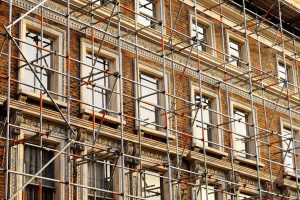 We are excited to announce that there has been a lot of C-PACE movement in Virginia over the past couple of months. The summary below provides an overview of the key highlights. Stay tuned for more information coming soon as C-PACE momentum is building across the Commonwealth.
We are excited to announce that there has been a lot of C-PACE movement in Virginia over the past couple of months. The summary below provides an overview of the key highlights. Stay tuned for more information coming soon as C-PACE momentum is building across the Commonwealth.
Attorney General Opinion
In response to a request from Loudoun County’s Attorney, the Virginia Office of the Attorney General issued an Advisory Opinion on the Commonwealth’s C-PACE law on February 1, 2019. The opinion clarifies two key issues: 1) local governments may authorize capital providers or third-party program administrators to perform billing and collecting of C-PACE loan payments, and 2) localities may assign rights to capital providers to record and enforce the voluntary special assessment liens that underlie C-PACE deals in the case of defaults. The full letter can be viewed here.
Loudoun County
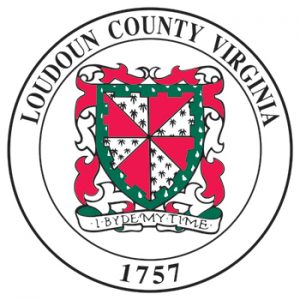 Since the release of the Attorney General’s Advisory Opinion, Loudoun County has been moving ahead at full force. The Board of Supervisors approved the County’s ordinance on February 21st. Now the County is in the procurement process for a third-party program administrator. The RFP is in development and is currently on schedule to be released later this month.
Since the release of the Attorney General’s Advisory Opinion, Loudoun County has been moving ahead at full force. The Board of Supervisors approved the County’s ordinance on February 21st. Now the County is in the procurement process for a third-party program administrator. The RFP is in development and is currently on schedule to be released later this month.
Fairfax County
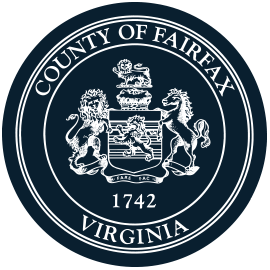 Back in January of this year, the VAEEC participated on the Fairfax County C-PACE Stakeholder Group to provide feedback on the County’s draft ordinance. Since the passage of SB 1559, the County plans to add resiliency measures to this ordinance, which is now scheduled to be considered by the Board of Supervisors on March 19th.
Back in January of this year, the VAEEC participated on the Fairfax County C-PACE Stakeholder Group to provide feedback on the County’s draft ordinance. Since the passage of SB 1559, the County plans to add resiliency measures to this ordinance, which is now scheduled to be considered by the Board of Supervisors on March 19th.
Hampton Roads
The Virginia Energy Efficiency Council partnered with the Hampton Roads Chamber of Commerce, the Mid-Atlantic PACE Alliance, Sustainable Real Estate Solutions (SRS), Viridiant, and the Virginia PACE Authority (VPA) to host a C-PACE workshop for the Hampton Roads region. This was one of our most attended C-PACE events to date, with over 50 people present. The room consisted of representatives from the Cities of Norfolk and Portsmouth, along with area developers, property owners, contractors, engineers, and architects.
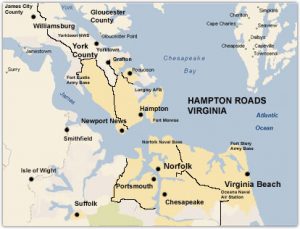
Speakers included Abby Johnson (VPA), City Councilmember Andria McClellan (Norfolk), Jessica Greene (VAEEC), Rob McRaney (Viridiant), and Scott Dicke (SRS). Topics covered included the value proposition of C-PACE for the Hampton Roads region, a history of C-PACE in Virginia, program administration basics, case studies, and action steps to bring C-PACE to the area. The full presentation can be viewed here.
Along with spreading the word about C-PACE, participants were encouraged to contact their local officials to urge the adoption of a C-PACE program. This includes contacting city councilmembers via phone, email, or by submitting letters of support. The VAEEC has created template letters of support that interested property owners, developers, or contractors can use to send to their local officials. Over the course of the past few years, the VAEEC has seen how constituent support and outreach plays a critical role in getting localities to move forward with developing a program.
If you would like to submit a letter to your local officials, the templates can be found below. Contact Jessica Greene (jessica@vaeec.org) with any questions.
2019 General Assembly: passage of two C-PACE bills
Senate Bill 1559 (Sen. Lynwood Lewis) was introduced to amend the current Commercial Property Assessed Clean Energy (C-PACE) statute to add “shoreline resiliency” to the list of projects that can be financed using C-PACE. VAEEC members Abby Johnson of the Virginia PACE Authority and Attorney Bill Nusbaum, along with Cliff Kellogg, drafted proposed amendments to expand the bill’s reach to cover all resiliency improvements as well as stormwater management measures. State staff also contributed language modifying the stormwater management reference by adding “with a preference for natural or nature-based features and living shorelines”. Further amendments also clarified the language around the need for a local government to specify a “maximum aggregate dollar amount” financeable under a C-PACE program in a local ordinance. In the amended version, a cap on total dollars allowed by a program would only be required if public funds were utilized. By contrast, if a C-PACE project were privately financed, then only a total project cap would be needed. The House approved the bill 99-0, and it was signed by the President of the Senate on February 22nd as SB1559ER.
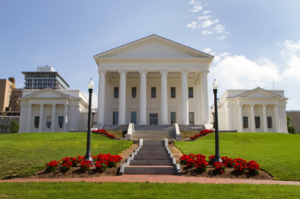 Senate Bill 1400 (Sen. J. Chapman Petersen) was introduced to add stormwater management to the list of projects that could be financed using C-PACE. Initially, this bill also authorized localities to establish Residential Property Assessed Clean Energy (R-PACE) financing; however, this language was stricken from the bill. By February 20th, the bill unanimously passed the House and the Senate to allow for C-PACE financing of stormwater management.
Senate Bill 1400 (Sen. J. Chapman Petersen) was introduced to add stormwater management to the list of projects that could be financed using C-PACE. Initially, this bill also authorized localities to establish Residential Property Assessed Clean Energy (R-PACE) financing; however, this language was stricken from the bill. By February 20th, the bill unanimously passed the House and the Senate to allow for C-PACE financing of stormwater management.
Both bills are now headed to the Governor’s desk for signature, and the new amendments will become effective on July 1, 2019. We hope that by making financing of resiliency and stormwater improvements available, more localities will adopt a C-PACE ordinance, thus making energy saving and renewable energy benefits of C-PACE more broadly available across Virginia.
We are excited to see such progress happening within these past few months and look forward to seeing more C-PACE programs come online across Virginia. For more information about C-PACE, check out our webpage, vaeec.org/PACE.


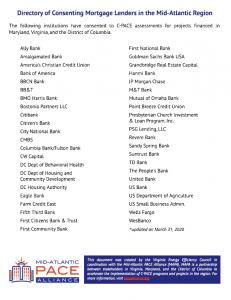
 We are excited to announce that there has been a lot of C-PACE movement in Virginia over the past couple of months. The summary below provides an overview of the key highlights. Stay tuned for more information coming soon as C-PACE momentum is building across the Commonwealth.
We are excited to announce that there has been a lot of C-PACE movement in Virginia over the past couple of months. The summary below provides an overview of the key highlights. Stay tuned for more information coming soon as C-PACE momentum is building across the Commonwealth. Since the release of the Attorney General’s Advisory Opinion, Loudoun County has been moving ahead at full force. The Board of Supervisors approved the County’s ordinance on February 21st. Now the County is in the procurement process for a third-party program administrator. The RFP is in development and is currently on schedule to be released later this month.
Since the release of the Attorney General’s Advisory Opinion, Loudoun County has been moving ahead at full force. The Board of Supervisors approved the County’s ordinance on February 21st. Now the County is in the procurement process for a third-party program administrator. The RFP is in development and is currently on schedule to be released later this month. Back in January of this year, the VAEEC participated on the Fairfax County C-PACE Stakeholder Group to provide feedback on the County’s draft ordinance. Since the passage of SB 1559, the County plans to add resiliency measures to this ordinance, which is now scheduled to be considered by the Board of Supervisors on March 19th.
Back in January of this year, the VAEEC participated on the Fairfax County C-PACE Stakeholder Group to provide feedback on the County’s draft ordinance. Since the passage of SB 1559, the County plans to add resiliency measures to this ordinance, which is now scheduled to be considered by the Board of Supervisors on March 19th.
 Senate Bill 1400 (Sen. J. Chapman Petersen) was introduced to add stormwater management to the list of projects that could be financed using C-PACE. Initially, this bill also authorized localities to establish Residential Property Assessed Clean Energy (R-PACE) financing; however, this language was stricken from the bill. By February 20th, the bill unanimously passed the House and the Senate to allow for C-PACE financing of stormwater management.
Senate Bill 1400 (Sen. J. Chapman Petersen) was introduced to add stormwater management to the list of projects that could be financed using C-PACE. Initially, this bill also authorized localities to establish Residential Property Assessed Clean Energy (R-PACE) financing; however, this language was stricken from the bill. By February 20th, the bill unanimously passed the House and the Senate to allow for C-PACE financing of stormwater management.